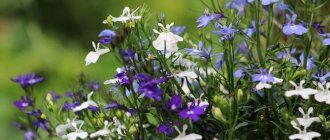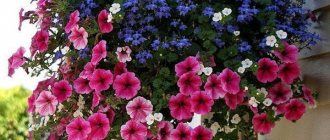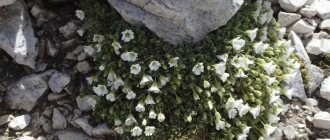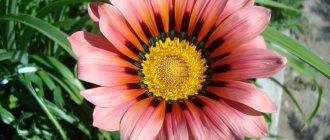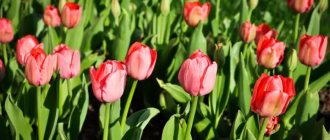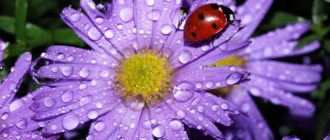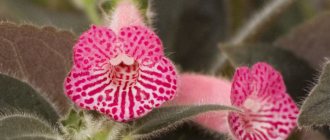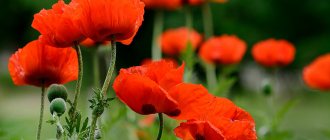Meet the flower
The most widespread are plant varieties with flowers in blue and blue shades. A distinctive feature of lobelia flowers is that even pink inflorescences have a purple tint.
Shoots, depending on the variety, can have a length from 15 to 40 centimeters. The direction of shoot growth also depends on the variety; they can either fall down or grow straight up.
Speaking about the description of the plant, it is worth mentioning that with proper placement on the site and care, lobelia can delight its owners with impressive flowering until the fall.
Description of perennial lobelia
Lobelia is a genus of perennial herbaceous plants from the Campanaceae family. In nature, it is found in the tropical zone of South Africa, so in Russia it is mainly grown as an annual (dug up and stored indoors for the winter).
In appearance, the plant is a low bush, on average 30-50 cm (some varieties up to 120 cm) with thin shoots and elongated leaves of a rich green color. The flowers are small, up to 2-3 cm in diameter and very numerous. Often they completely cover the bush, creating a lush floral carpet with a variety of inflorescences:
- white;
- pink;
- purple;
- lilac;
- blue;
- blue;
- purple.
Moreover, lobelia blooms en masse - the bush is covered with inflorescences throughout its entire volume at about the same time. Flowering continues throughout the summer and ends in early September. The total duration depends on the specific type and variety, but in general the decorative period is at least 2 months.
After this, the plants produce fruits - dry capsules with numerous small seeds. They can be carefully transferred to a container and stored in the refrigerator (2-5 degrees Celsius). Moreover, under such conditions, the grains will retain their viability for at least 2 years.
Perennial lobelia - a classic ground cover plant
Planting by seeds
To grow seedlings from lobelia seeds, it is recommended to choose loose soil with neutral acidity. To save time and effort, it is possible to purchase ready-made soil in specialized stores. The ideal substrate for growing would be sand, humus, peat and turf soil.
It is possible to use pots, boxes, jars or cut plastic bottles as containers for growing. After selecting containers, they need to be disinfected; for this you can use potassium permanganate. Each container must have holes in the bottom, and you also need to organize a drainage layer using expanded clay or small crushed stone.
To obtain a plant capable of flowering by the beginning of the season, seeds should be sown in February. The prepared containers need to be filled with soil and spilled with fungicide. Next, on a paper sheet, the seeds are mixed with fine sand. By tilting the leaf, you need to evenly distribute the seeds over the surface of the soil.
After sowing, it is recommended to spray the seeds with a growth stimulator. After that, the containers should be covered with glass or transparent film and placed in a dark, warm place. The containers are exposed to light after the first shoots appear, this happens within 5-6 days.
It is recommended to start diving no earlier than a month after the first shoots appear. When performing a dive, some patience and diligence will be required. To do this, you can use tweezers or a toothpick. With their help, you will need to separate the seedlings from the solid carpet.
In order to facilitate the process, it is possible to cut the mat of seedlings into small pieces and plant them in separate containers. Before starting work, you need to thoroughly moisten the soil in the container with the sprouts. 6-7 days after planting, it is recommended to feed the seedlings with complex fertilizers.
What plants does it go with?
Perennial lobelia is a universal plant because it goes well with almost all ornamental crops that are suitable for its height (20-120 cm). In compositions it is often planted next to the following:
- bell;
- carnation;
- petunia;
- verbena;
- balsam;
- carnation;
- pelargonium;
- hosta
Perennial lobelia decorates flower beds and is used in mixborders, rock gardens and rockeries:
- Lobelia and hosta.
- In the rock garden.
- On a decorative flowerbed.
- In a large container.
- Rocky hill.
Planting seedlings
The time to plant lobelia depends on the region. It is necessary to wait until the cold weather completely subsides and the soil warms up. When planting lobelia, you should avoid excessively enriching the soil in the holes, as this will lead to too active development of greenery, and this in turn will negatively affect the abundance of flowering. For the same reason, you should not be overzealous with fertilizing throughout the season.
Before planting, you need to prepare holes with a diameter of about ten centimeters, at the bottom of which it is worth organizing a drainage layer.
Seedlings are planted by transshipment, that is, without destroying the earthen lump formed on the root system. The distance between the holes with plants should not be less than ten centimeters if it is planned to form a carpet.
If you plan to grow free-standing bushes, then the distance should be at least 25 centimeters. Then the hole is filled with soil, lightly compacted and watered with warm water.
For better adaptation and survival of new plants, it is advisable to cover them from the wind for the first few days. This can be done using transparent film or a plastic bottle with the bottom cut off.
Diseases and pests
Perennial lobelia is characterized by resistance to various diseases or pests. But under conditions of excessive watering or heavy rainfall, it can suffer from root rot. It is also possible that it can be affected by fungal infections such as rust and powdery mildew, as well as viral mosaic disease. Therefore, it is advisable to treat seedlings transplanted into a flowerbed with fungicides:
- "Profit";
- "Maksim";
- "Fitosporin";
- "Tattu";
- Bordeaux mixture 1%.
In summer, bushes can be parasitized by slugs, spider mites and thrips. If possible, they are collected by hand, after which the plants are treated with insecticides:
- "Fitoverm";
- "Aktara";
- "Decis";
- "Vertimek";
- "Confidor".
Advice! To repel slugs, scatter nut shells, eggshells or stone chips, as well as crushed chili peppers around the flower bed with perennial lobelia and other plants.
Effective care for decent results
Planting and caring for lobelia in open ground will not require much effort or a lot of time, but to obtain the desired result, you still need to perform some operations:
- the plant loves a lot of sunlight, but you still need to try not to expose it to direct scorching sunlight;
- when watering abundantly in hot weather, you need to periodically loosen the soil in order to avoid stagnation of water near the root system;
- it is necessary to exclude any nitrogen fertilizers when fertilizing;
- It is recommended to prune lobelia after the first flowering.
Reviews from gardeners
Owl-hoo, Chertanovo
I sowed lobelia on a damp napkin, in a salad jar, and after the seeds hatched and released cotyledons, I planted them in the ground in bunches.
Source: www.forumhouse.ru
Lobelia, Zhukovsky
After planting plants in all sorts of pots and flowerpots, lobelia is very responsive to fertilizing with potassium sulfate, the flowering is so abundant that you cannot find greenery among its flowers.
Source: www.forumhouse.ru
Watering and fertilizing
A competent approach to growing lobelia requires compliance with care rules, including watering rules. In order for the plant to look fresh, bloom profusely and develop well, it is necessary to provide watering every three days.
There is no doubt that you need to build on the weather conditions. Both excessive drying of the top layer of soil and excessive humidity should not be allowed.
It is best to fertilize the soil in the holes once every two weeks, and it is recommended to use liquid complex fertilizers intended for flowering plants.
Lobelia in landscape design
Lobelia in garden landscape design works well as a container plant; it is able to quickly create an impressive cascade of its flowers in containers of any size and shape. Decorative qualities are perfectly demonstrated when using only lobelia in decoration using color shades of different varieties.
Lobelia is moisture-loving, and when creating mixed container compositions, it is worth choosing plants with similar watering requirements as partners. A bright and attractive result is possible when planted together with snapdragons, marigolds, calendula, gillyflower, petunia, celosia, coleus, geranium and other favorites of gardeners.
The ability of lobelia to tolerate shading well and bloom profusely expands its range of landscaping on dimly sunlit building walls, among dense high-rise buildings. Here, annual and low perennial plants will become wonderful companions - heuchera, dwarf hosta, ageratum, balsam, fuchsia, viola, seaside cineraria, woolly begonia, ever-flowering and tuberous begonias.
The openwork blue of lobelia flowers looks wonderful in combination with perennial plants and shrubs with a dense crown (spirea, euonymus, clipped conifers, etc.) or succulent dense leaves (sedum, hosta, iris, peony), along the water's edge near the garden pond.
Framing rose bushes with lobelia will cover the bare parts of roses near the ground and will become a good background for varieties with light flowers when using richly colored lobelia varieties (crimson, blue, violet). Roses with dark flowers will gain additional expressiveness in a duet with white or soft lilac lobelia and in combination with plants with densely pubescent or bluish leaves.
The highlight of the landscape design of the site will be flower beds decorated with perennial purple or cardinal lobelia. Garden literature often indicates its unsuitability for the Russian climate. However, practice shows good winter hardiness under a spanboard cover. Bright red candles over half a meter high will decorate flower beds in the second half of summer; the total height of the plant with good care is up to one and a half meters. It will be good in a “village” front garden, a mixed flower garden with shrubs and trees, it will cover a fence or a neighbor’s picket fence with greenery, and it will decorate a flower garden by the gate.
Trimming
It is possible to prune lobelia several times during the season. Basically, these procedures are of the nature of imparting aesthetics to the shape of the bushes, but pruning after the first flowering is the most important. It must be done in such a way that the stems are about five centimeters long from the ground.
It is this pruning that, 12-14 days after its completion, triggers the second wave of lobelia flowering. Most often, the second flowering is much more lush and abundant than the first.
Types and varieties of lobelia
Today, about 300 varieties of this flower are known, and more than 20 are grown in cultivation. The most popular and beautiful varieties of lobelia with photos and descriptions are presented below.
Lobelia erinus
This is the most common type - a dwarf plant (height from 10 to 40 cm). The photo of this lobelia flower shows that it forms a classic spherical bush. There are a lot of inflorescences, varied colors: pink, lilac, sky blue, purple.
Main varieties:
- Regatta Rose - flowers of a lilac-pink hue.
- Regatta Blue – deep blue color.
- Sky Blue - sky blue.
Lobelia ampelous
Perennial lobelia with thin stems creeping along the ground. The height is small - up to 15 cm. Used in flower pots, as well as in decorative flower beds. For example, such a plant can be planted on a hill, allowing the stems to descend to the ground.
Main varieties:
- Sapphire - bright blue flowers.
- Red Cascade – deep pink.
Lobelia is beautiful
An unusual type of lobelia with erect shoots growing up to 70-90 cm. The flowers are tubular, quite large (up to 3 cm in diameter). The color is pink, bright red, carmine.
Main varieties:
- Russian princess - purple-bronze leaves, bright red inflorescences.
- Fan Scarlet is a perennial lobelia with bright red flowers.
- Deep Red Compliment - brown stems and velvety flowers of a rich red hue. The bush grows up to 70 cm tall.
Lobelia cardinalis
Another type of erect perennial lobelia up to 100 cm in height. The inflorescences are large, bright red, spherical in shape. Used mainly in single plantings.
Perennial lobelia cardinalis, thanks to its bright color, is visible from anywhere in the garden
Photo of lobelia plant
Outdoor care
The plant is quite capricious at the stage of growing seedlings, but after planting in a permanent place there are few problems with growing a highly decorative species. The seedlings are thread-like and weak in appearance, but in a sunny area they quickly grow stronger, with regular care they grow well and turn into strong, healthy plants.
Watering
The soil should be moderately moist, but the plant should not be flooded. Leaves and flowers form a lush above-ground layer, the rate of moisture evaporation decreases: this point must be taken into account. Take settled, lukewarm water, water it carefully from a watering can with a long spout, making sure that no moisture gets on the leaves and buds. In hot weather, with rare rains, you need to carefully monitor the condition of the substrate: the soil should not dry out.
Feeding and fertilizer
Two waves of flowering require enough strength from the plant to form buds and maintain lush greenery. After planting the seedlings, about a week later, complex fertilizer or liquid biohumus is applied. In July, it is useful to add a phosphorus-based composition, and before the second wave of flowering, products containing more potassium are added.
Lobelia is fed sparingly. Granules or liquid formulations are added under the bushes after the substrate has been moistened.
Warning! It is forbidden to introduce strong organic matter, for example, fresh manure, so as not to burn the roots and tender leaves touching the ground.
Care during and after flowering
Lobelia has a specific feature - two waves of bud appearance. In mid-summer, after the end of the first stage of flowering, the bushes are trimmed so that a base about 5 cm high remains. A deficiency of green mass stimulates the formation of new buds: the plant spends little energy and juices on feeding the leaves, which are practically gone.
Before flowering and during the period of bright colors, it is useful to add a small amount of potassium-phosphorus fertilizers every week to maintain the high decorativeness of the species. It is important to add half the fertilizing norm to the soil to avoid exceeding the nutritional value of the soil.
Bush formation
Ampelous species cover the area or decorative elements with a beautiful, lush “carpet”. To stimulate re-blooming, in the middle of summer, overgrown greenery is trimmed: there is a higher probability of new buds appearing.
Mulching, loosening
When growing lobelia in regions where it rarely rains and moisture quickly evaporates after watering, it is useful to sprinkle the soil under the bushes with a layer of mulch 1 cm thick. Organic components are used: crushed peat or chopped straw.
Light loosening is a good protection against “heaviening” the soil and the formation of a dense crust. During the procedure, oxygen access to the roots increases. As work progresses, the owner removes weeds. If you mulch the substrate immediately after planting the seedlings, the weeds grow weaker. In case of high crowding of plantings, it is useful to thin out the bushes a little or remove weeds with your hands, so as not to damage the fragile stems, leaves and buds of hanging lobelia species.
Planting and caring for Lobelia cardinalis in an aquarium
Lobelia purpurea is an aquarium plant, so it feels much better in water than on land, and care is not difficult. It is planted along the walls - back or side, placing the roots in rocky soil, where it develops well when certain conditions are created:
- water temperature - +25 ⁰С;
- hardness – 5-15;
- illumination for 10 hours or more;
- neutral reaction.
Important! The tops of Lobelia purpurea are pinched before they reach the surface of the water to prevent flowers from forming above it.
For full development, the plant requires an aquarium with a volume of 40 liters or more.
Growing lobelia on the balcony
Many people decorate their balconies with lobelia. Familiar window sills “come to life” from such guests. Typically, the following varieties are used for growing on balconies:
- Cardinal;
- Rosamund;
- Syphilitic;
- Blue fountain;
- Dortman;
- Fiery.
The varieties described above are low-growing and densely growing - an excellent option for decorating balconies and loggias. Seedlings are planted in permanent pots, cache-pots or containers.
They dive into light and nutritious soil when the plants reach about 4-5 centimeters in height. It is convenient to replant them with a spoon, picking up the plants along with the soil. Leave about 4 centimeters between the shoots and tamp them down a little.
When they grow to 8 centimeters, the tops are pinched - we will talk about this below.
Seedlings can be transplanted onto an uninsulated balcony when the temperature outside the window remains within +15 degrees. Lobelia can withstand a one-time drop in temperature down to -2 degrees. This will not cause any problems, but only within one day.
In cloudy weather and short daylight hours, you need to highlight the sprouts. But, despite their addiction to light, direct sunlight should be avoided, especially through glass - they can die. The most ideal temperature for flowering is 25 degrees Celsius.
Since this species loves humidity, it needs to be maintained at 50-60%. They need to be watered every day. At the same time, you cannot overfill. Water should be absorbed into the soil without leaving any residue. On a particularly hot day, it is better to water them twice – in the morning and in the evening. Be sure to make holes at the bottom of the pots for ventilation and release of excess moisture.
Watering is carried out strictly under the root. Droplets of water on a plant on a hot sunny day can cause severe burns. It is better to fertilize the plants on the balcony 2 times a month with mineral substances for flowers, according to the instructions. At the same time, it is better to avoid fertilizers with a high nitrogen content. In excess, it leads to slower growth.
Answers to frequently asked questions
What is the best substrate to sow seeds in?
Preference should be given to the one sold in specialized stores, since all the vitamins and microelements in it are balanced.
Seeds do not germinate, what should I do?
There may be several reasons for this: the seeds are old or affected by diseases, lack of sunlight, improper care. To solve this problem, the growing conditions should be reconsidered; this is most likely the reason.
